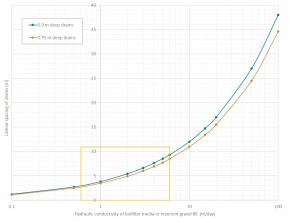Hooghoudt
Revision as of 14:32, 13 June 2019 by Jenny Hill (talk | contribs)
The printable version is no longer supported and may have rendering errors. Please update your browser bookmarks and please use the default browser print function instead.
Spacing drainage pipes to reduce groundwater mounding[edit]
In most LID underdrain applications, lateral drains should be spaced between 5 - 6 m apart. This recommendation is supported by an analysis of Hooghoudt's equation [1][2][3] in relation to loamy or clayey native soils, where Kmedia>>Ksoil, finds the first term of the numerator negligible, so that the original equation: may be simplified to:
Where:
- Kmedia is expressed in m/day
- Dd is the depth to the drain pipe (m)
- Dw is the minimum acceptable depth to the water table during infiltration event
- q is the inflow volume expressed as a depth over the entire surface (m)
- ↑ H.P.Ritzema, 1994, Subsurface flow to drains. Chapter 8 in: H.P.Ritzema (ed.), Drainage Principles and Applications, Publ. 16, pp. 236-304, International Institute for Land Reclamation and Improvement (ILRI), Wageningen, The Netherlands. ISBN 90-70754-33-9
- ↑ W.H. van der Molen en J.Wesseling, 1991. A solution in closed form and a series solution to replace the tables for the thickness of the equivalent layer in Hooghoudt's drain spacing equation. Agricultural Water Management 19, pp.1-16
- ↑ van Beers, W.F.J. 1976, COMPUTING DRAIN SPACINGS: A generalized method with special reference to sensitivity analysis and geo-hydrological investigations, International Institute for Land Reclamation and Improvement (ILRI) Wageningen, The Netherlands


